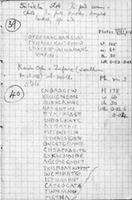 MAMA XI 216 (Axylon)
MAMA XI 216 (Axylon) 
Funerary stele with inscription in verse
- Type of monument:
- Funerary stele.
- Location:
- Zaferiye (Kayışoğlu) (Axylon): at a well in the southern mahalle.
- Description:
- Stele with vaulted pediment. In the pediment, a boss; below it, two bosses flanking a diagonal object in the shape of a lock-plate.
- Dimensions:
- Ht. 1.78; W. 0.65; Th. 0.30; letters 0.020-0.040.
- Record:
- WMC notebook copy; photograph (double-exposed) (1954/40).
- Publication:
- None.
- Date:
- Fourth or fifth century AD.
ἐνθάδ᾿ ἐγὼ
κεῖμε νέον
ἄνθος ἀμφε-
μαραντήν (?)·
5πυκρὸν δὲ π-
ένθος κατέ-
λυπα τοῖς
με γονεῦσιν.
νῦν δέ με πεν-
10θήσετε πάντε-
ς ἡ παροδεῖτε·
εὐκάς μοι θε-
λέσετε (?) ἐμῇ ψ-
υχῇ· πολυκούπ-
15ως (?) μνῆμα ΤΕ̣[. ]
ἰστήλλην [- - -]
σατεο̣σατα[- - -]
των μνη[μ- - -]
μετηλ[λακχότι] (?), [τ]-
20ὸ γὰρ γ[έρας ἐστὶ]
θανό[ντων - -]
αυ[- - - - -]
- - - - - - - - - -
I lie here, a new flower withered all around (?); I have left bitter grief for my parents. Now grieve for me, all you passers-by; may you wish (?) prayers for my soul (?); with great labour, memorial... stele... [for the] dece[ased?], for that is the h[onour due to] the dead...





Calder’s photograph of this difficult verse inscription was double-exposed, with the result that we are largely dependent on his notebook copy. In lines 3-4, I assume that we have a part of a putative verb *ἀμφιμαραίνειν, ‘to wither on all sides’, formed on the model of the common compound ἀπομαραίνειν. Here the author of the inscription appears to have produced a confused hybrid of the aorist passive participle (ἀμφι)μαρανθέν and the aorist passive indicative (ἀμφ)εμαράνθη. The phrase νέον ἄνθος (lines 2-3) is found in combination with the verb ἀπομαραίνειν in another Late Antique funerary inscription from the Axylon, MAMA I 381 (Zengen [Özkent]), ἐγὸ Φοτῆνος πρεσβύτερος νέον ἄνθος ἀφεμαράθη (cf. SEG 36, 1183 [Germia], ἔνθα κατάκιτε νέον ἄνθος Θεόδωρος; TAM V 1, 481). For the phraseology, compare Parthenius fr.55a.3 (ed. Lightfoot 1999), [- - μα]ρ̣αίνεται ὡς νέον ἄνθος.
The adverb πολυκόπως (lines 14-15) seems not to be attested elsewhere, but its formation is regular (cf. e.g. πολυπόνως): cf. IAph2007 12.920, lines 31-3, δα[π]ανήμασιν ἱκανοῖς καὶ κόπῳ πολλῷ περιεγένετο; I.Klaudiu Polis 75, πολὰ κοπωθέντι; SEG 43, 923 (Pompeiopolis), ἐ⟨κ⟩ κόπων ἐμῶν ποιήσας κενοτάφιν.
In lines 20-21, I have restored the Homeric formula τὸ γὰρ γέρας ἐστὶ θανόντων (Il. 16.457; 16.675; 23.9; Od. 24.190; 24.296), a popular tag in the funerary epigraphy of this part of Asia Minor; cf. also SEG 6, 291 (Merkelbach and Stauber 2001: 14/04/02, Gözlü); MAMA VII 560 (Merkelbach and Stauber 2001: 14/02/04, Kuyulusebil); Cronin 1902: 349, no. 89 (Merkelbach and Stauber 2004: 14/07/12, Konya); I.Konya 56 (Merkelbach and Stauber 2004: 14/07/11, Konya); I.Tyana 104 (Merkelbach and Stauber 2001: 13/07/02); RECAM II 233 (Merkelbach and Stauber 2001: 15/02/98, Yaylabey); RECAM II 338 (Çekirge).